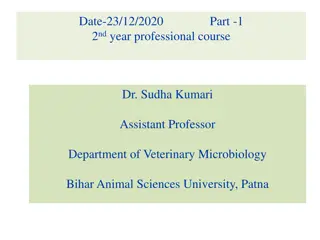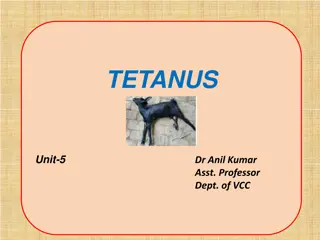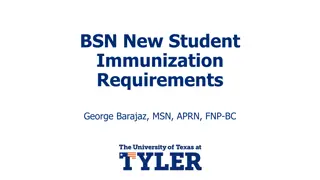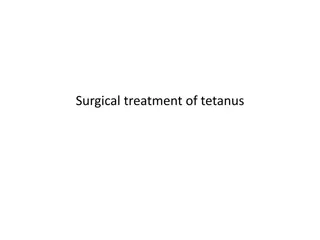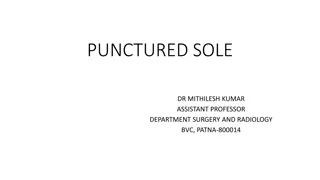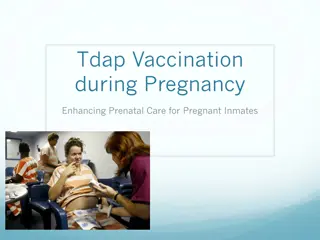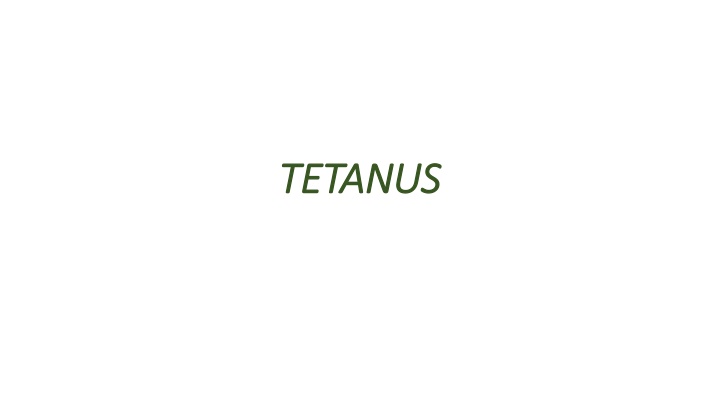
Tetanus: Causes, Symptoms, and Prevention
Tetanus is an infectious disease caused by the bacterium Clostridium tetani found in soil and animal feces. It leads to muscle rigidity and spasms, with potential life-threatening complications if untreated. Learn about its incidence, risk factors, and how proper immunization can prevent it.
Download Presentation

Please find below an Image/Link to download the presentation.
The content on the website is provided AS IS for your information and personal use only. It may not be sold, licensed, or shared on other websites without obtaining consent from the author. If you encounter any issues during the download, it is possible that the publisher has removed the file from their server.
You are allowed to download the files provided on this website for personal or commercial use, subject to the condition that they are used lawfully. All files are the property of their respective owners.
The content on the website is provided AS IS for your information and personal use only. It may not be sold, licensed, or shared on other websites without obtaining consent from the author.
E N D
Presentation Transcript
TETANUS TETANUS
Introduction Introduction It s infectious disease caused by contamination of wounds from the bacteria clastridium tetani, or the spores they produce that live in the soil, and animal feces. Greek words tetanos and teinein , meaning rigid and stretched. Clastridium tetani produces two toxins, Tetanolysin (caused red cell lysis ) Tetanospasmin (muscles spasm or rigidity) Tetanus spores are found throughout the environment, usually in soil, dust, and animal waste.
Tetanus is acquired through contact with the environment, it is not transmitted from person to person. As the infection progresses, muscle spasm in the jaw develops, hence the common name lockjaw. This is followed by difficulty swallowing & general muscle stiffness and spasm in other parts of the body. Infection can be prevented by proper Immunization & by post exposure prophylaxis. Incubation period varies from 1 day to several months, but usually about eight days.
Incidence Incidence Around a million cases occur worldwide each year. If the patient does not receive treatment the risk of life threatening complications is higher mortality rates reported vary from 40-78%. In 2013 it caused about 59,000 deaths.
Tetanus Tetanus Tetanus is a medical condition characterised by prolonged contraction of skeletal muscles fibres. Etiology The bacteria that cause tetanus, clastridium tetani, are found in soil, dust, and animal feces. When they enter a deep flesh wound, spores of the bacteria may produce a powerful toxin, Tetanospasmin, which activly impairs your motor neurons, nerve that control your muscles. The effect of toxin can couse muscle stiffness and spasm. They cause tetanus in both man and animal.
Risk factors Risk factors Tetanus cases have developed from the following types of injuries. Puncture wounds Gunshoot wounds Compound fractures Crush injuries Burns Surgical wounds Ear infections Animal bites Infected foot ulcers
Certain factors are necessary for tetanus bacteria to proliferate in your body. These include Lack of Immunization or inadequate Immunization failure to receive timely booster shoots against tetanus. The penetrating injury that result in tetanus spores being introduced to the wound site. The presence of other bacteria. Injured tissue. Swelling around the injury.
Types Types Local tetanus Persistant spasm of musculature at site of primary infection. Contractions persist for weeks before subsiding. Its generally milder, 1% cases are fatal but may preceded the generalized tetanus. Affects mainly the cranial nerve and facial nerve.
Cephalic tetanus Cephalic tetanus Primary site of infection is head injury or otitis media. Associated with dysfunction of one or more cranial nerves. Poor prognosis. Generalized tetanus Most commonly form 80% cases Presents with a descending pattern Follwed by stiffness of the neck, difficulty in swallowing, rigidity of abdominal muscles.
Neonetrum tetanus Neonetrum tetanus It is the generalized tetanus that occurred in newborn infants. Occurs in infants of non immunised mothers. occurs from infection of unhealed umbilical stump particularly when stump is cut with non-sterile instrument. Very poor prognosis. This has a faster acting progression and the incubation period is normally only 4 days. If the mother has been immunized against tetanus then this can help to give the child passive immunity.
Clinical manifestation Clinical manifestation Febrile, irritability Heavy sweating Contraction of the muscles at the angle of the mouth frintails Trismus lackjaw Opisthotonus Spasm of extensor of the neck, back and legs to form a backward curvature Bloody stools, diarrhoea, fever, headache, sensitivity to touch, sore throat, Tachycardia.
Pathogenesis Pathogenesis C tetani enters body fluids from wound. States in sporulated form until anaerobic conditions are presented. Germinates under anaerobic conditions and begins to multiply and produce tetanospasmin. Tetanospasmin spreads using blood and lymphatic system and binds to motor neurones. Travels along the axons to the spinal cord. Binds to sites responsible for inhibiting skeletal muscles contraction.
Complications Complications Once tetanus toxin has bonded to your nerve endings it is impossible to remove. Complete recovery from a tetanus infection require the growth of new nerve endings and can take up to several months. Broken bones. Disability Aspiration pneumonia Laryngospasm Pulmonary embolism Tetanic Seizures Severe kidney failure Septicemia Heart attack
Diagnosis Diagnosis Diagnosis made based on clinical presentation. Doctors Diagnose tetanus based on a physical examination Medical and immunisation history, and the sign and symptoms of muscle spasm stiffness and pain. laboratory tests generally are not helpful for diagnosing tetanus. specimen wound swab exudate or tissue from the wound. direct smear and Gram staining culture animal inoculation
Management Management There is no cure for tetanus treatment focuses on managing complications until the effects of the tetanus toxin resolve. Cleaning the wound is essential to preventing growth of tetanus Spores . Any patient with a tetanus prone wound should receive tetanus immunoglobulin as soon as possible even if he or she has been vaccinated. Antibiotics doctors may prescribe penicillin and metronidazole for tetanus treatment these antibiotics prevent the bacterium from multiplying and producing the neurotoxin that cause muscle spasm and stiffness.
Anticonvulsants this treat muscle spasms. Example diazepam and phin orbital muscle relaxants these drugs helps relieve symptoms of muscle stiffness example baclofen. Vaccine having tetanus once does not make you immune to the bacteria after word. So you will need to receive a tetanus vaccine in order to prevent future tetanus infection. Neuromuscular blocking agents are useful for controlling muscle spasm. Surgery is the doctor thinks the tetanus prone wound is very large he or she surgically removes as much of the damaged and infected muscle as possible.
Prevention Prevention Tetanus carries a 35% mortality rate making prevention very important the best course is childhood immunization with consistent booster doses and from cleaning of wound with hydrogen peroxide. Tetanus is completely preventable by active tetanus immunization. Immunization is third to provide protection for 10 years. Begins in infancy with the DTP series of shots. The DTP vaccine is a 3 in 1 vaccine that protects against diphtheria pertussis and tetanus.


